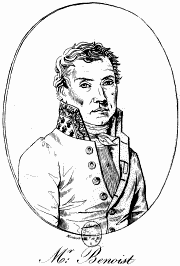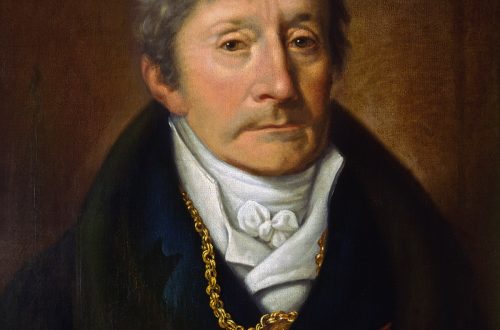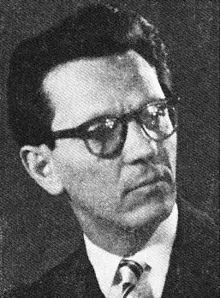
Uzeir Hajibekov (Uzeyir Hajibeyov) |
Uzeyir Hajibeyov
“… Hajibeyov devoted his whole life to the development of the Azerbaijani Soviet musical culture. … He laid the foundation of Azerbaijani opera art for the first time in the republic, thoroughly organized musical education. He also did a great deal of work in the development of symphonic music,” D. Shostakovich wrote about Gadzhibekov.
Gadzhibekov was born into the family of a rural clerk. Shortly after the birth of Uzeyir, the family moved to Shusha, a small town in Nagorno-Karabakh. The childhood of the future composer was surrounded by folk singers and musicians, from whom he learned the art of mugham. The boy sang folk songs beautifully, his voice was even recorded on a phonograph.
In 1899, Gadzhibekov entered the Gori teacher’s seminary. Here he joined the world, primarily Russian, culture, got acquainted with classical music. In the seminary, music was given a significant place. All students were required to learn to play the violin, receive the skills of choral singing and ensemble playing. Self-recording of folk songs was encouraged. In Gadzhibekov’s music notebook, their number grew from year to year. Subsequently, when working on his first opera, he used one of these folklore recordings. After graduating from the seminary in 1904, Gadzhibekov was assigned to the village of Hadrut and worked as a teacher for a year. A year later, he moved to Baku, where he continued his teaching activities, at the same time he was fond of journalism. His topical feuilletons and articles appear in many magazines and newspapers. Few leisure hours are devoted to musical self-education. The successes were so significant that Gadzhibekov had a daring idea – to create an operatic work that would be based on the art of mugham. January 25, 1908 is the birthday of the first national opera. The plot for it was Fizuli’s poem “Leyli and Majnun”. The young composer widely used parts of mughams in the opera. With the help of his friends, equally passionate enthusiasts of his native art, Gadzhibekov staged an opera in Baku. Subsequently, the composer recalled: “At that time, I, the author of the opera, knew only the basics of solfeggio, but had no idea about harmony, counterpoint, musical forms … Nevertheless, the success of Leyli and Majnun was great. It is explained, in my opinion, by the fact that the Azerbaijani people were already expecting their own Azerbaijani opera to appear on the stage, and “Leyli and Majnun” combined truly folk music and a popular classical plot.”
The success of “Leyli and Majnun” encourages Uzeyir Hajibeyov to vigorously continue his work. Over the next 5 years, he created 3 musical comedies: “Husband and Wife” (1909), “If not this one, then this one” (1910), “Arshin Mal Alan” (1913) and 4 mugham operas: “Sheikh Senan” (1909) , “Rustam and Zohrab” (1910), “Shah Abbas and Khurshidbanu” (1912), “Asli and Kerem” (1912). Already being the author of several works popular among the people, Gadzhibekov seeks to replenish his professional baggage: in 1910-12. he takes private courses at the Moscow Philharmonic Society, and in 1914 at the St. Petersburg Conservatory. On October 25, 1913, the premiere of the musical comedy “Arshin Mal Alan” took place. Gadzhibekov performed here both as a playwright and as a composer. He created an expressive stage work, sparkling with wit and full of cheerfulness. At the same time, his work is not devoid of social poignancy, it is full of protest against the reactionary customs of the country, degrading human dignity. In “Arshin Mal Alan” the composer appears as a mature master: the thematic is based on modal and rhythmic features of Azerbaijani folk music, but not a single melody is borrowed literally. “Arshin Mal Alan” is a true masterpiece. The operetta went around the world with success. It was staged in Moscow, Paris, New York, London, Cairo and others.
Uzeyir Hajibeyov completed his last stage work – the opera “Kor-ogly” in 1937. At the same time, the opera was staged in Baku, with the participation of the famous Bul-Bul in the title role. After the triumphant premiere, the composer wrote: “I set myself the task of creating an opera that is national in form, using the achievements of modern musical culture… Kyor-ogly is ashug, and it is sung by ashugs, so the style of ashugs is the prevailing style in the opera… In “Ker-ogly” there are all the elements characteristic of an opera work – arias, duets, ensembles, recitatives, but all this is built on the basis of the modes on which the musical folklore of Azerbaijan is built. Great is the contribution of Uzeyir Gadzhibekov to the development of the national musical theater. But at the same time he created many works in other genres, in particular, he was the initiator of a new genre – romance-gazelle; such are “Sensiz” (“Without you”) and “Sevgili janan” (“Beloved”). His songs “Call”, “Sister of Mercy” enjoyed great popularity during the Great Patriotic War.
Uzeyir Hajibeyov is not only a composer, but also the largest musical and public figure in Azerbaijan. In 1931, he created the first orchestra of folk instruments, and 5 years later, the first Azerbaijani choral group. Weigh Gadzhibekov’s contribution to the creation of national musical personnel. In 1922 he organized the first Azerbaijani music school. Subsequently, he headed the musical technical school, and then became the head of the Baku Conservatory. Hajibeyov summarized the results of his studies of national musical folklore in a major theoretical study “Fundamentals of Azerbaijani Folk Music” (1945). The name of U. Gadzhibekov is surrounded in Azerbaijan by national love and honor. In 1959, in the homeland of the composer, in Shusha, his House-Museum was opened, and in 1975, the opening of the House-Museum of Gadzhibekov took place in Baku.
N. Alekperova





